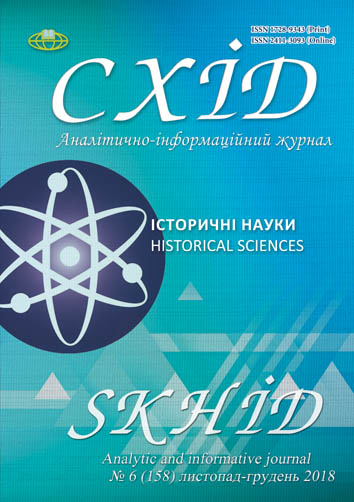The first student building units in the everyday life of Ukrainian students
DOI:
https://doi.org/10.21847/1728-9343.2018.6(158).154953Keywords:
students, everyday life, student construction brigades, USSR, virgin landAbstract
The history of everyday life is becoming increasingly relevant in our time. Studies of the life of an ordinary person, a social group, their way of life, and life stances allows to understand better the peculiarities of one or another historical epoch. The history of the students, their role in the socio-political and economic development of the state has always been relevant in historical science. Scientific interest in this problem is due to the fact that the younger generation has always been hoping for humanity. The quality of life of students, their professional and moral preparation as litmus paper shows the level of development of the state.
The purpose of the research is to find out the processes of formation of building units, motivation of youth; to identify the peculiarities of the students' work, the difficulties they encountered and the peculiarities of the process of socialization in the middle of the students collective. The author involves archival sources, namely protocols of meetings of student units, reports on the work of virgin units, certificates, etc.
The history of student construction units is a tradition, experience and reservations. Of particular interest to historical science is the everyday life of the Buddhists, because it has become part of the spiritual culture of many generations of students, in some sense determined their future. Together with the students' building detachments the whole epoch has definitely gone.
Student building units - labor collectives of students who voluntarily unite during the summer holidays for participation in the construction of national economic objects and propaganda, cultural-mass and other chess work among the population.
The tasks of communist socialization demanded that students during their studies in higher educational institutions acquire not only deep knowledge of the chosen specialty, but also prepare themselves for active participation in the social and political life of Soviet society.
The analysis of sources and literature suggests that during the early 1960s the birth and formalization of student construction units took place. The initiative of young people to help build their country was well used and bureaucratized by the Soviet-party bodies. But despite this, the movement of young people has become more widespread and enthusiastic, as evidenced by the memories of the participants in the third semester.
Downloads
References
State Archive of Public Associations of Ukraine. Fond 7. Opys 15. Sprava 71.
State Archive of Public Associations of Ukraine. Fond 7. Opys 20. Sprava 51.
State Archive of Public Associations of Ukraine. Fond 7. Opys 20. Sprava 153.
State Archive of Public Associations of Ukraine. Fond 7. Opys 20. Sprava 148.
State Archive of Public Associations of Ukraine. Fond 7. Opys 20. Sprava 357.
State Archive of Public Associations of Ukraine. Fond 7. Opys 20. Sprava 254.
State archive of Kharkiv region (DCA, Kharkiv) F. R. 5649. Opys 11. Sprava 13.
Honored semesters of student construction units of Ukraine. 2008. Documentary-artistic dilemma. Polifast Publishing, Fastiv, 528 p. (ukr).
Ivanenko, S.P. and Sazonov, I.E. 2002. Student labor groups: experience, analysis, prospects.St. Petersburg, Available at: http://ivanenkovs.narod.ru (Accessed 11 December 2018).
Kolyada, I.and Ralko, R. 2012. Journal Krayeznavstvo, Issue 2, Students' Buddy pens: before the history of the patriotic school students in URSR (1962-1989 p.), рp. 141-149 (ukr).
Petrovsky, V.V. 2016. News of KhNU seriya «Istoriya». Issue 52, «Test by the North»: an essay on the history of student construction teams of the Kharkiv and Tyumen Oblasts: 90-98.
Collection of documents regulating the financial and economic activities of student detachments, Regulations on the student detachment,Moscow, 1988: Article 9-10.
Resolution of the Central Committee of the CPSS and the Council of Ministers of theUSSRof May 26, 1967 No. 483 «On Measures for Improving the Organization and Improving the Efficiency of Students' Summer Work»,USSRSP, 1967, N 13, art. 86.
Ralko, R.S. 2013. Students labor groups in the URSR: before the problems of the socialist youth of the youth (60-80th age of the Twentieth century). Bulletin of Cherkasy University, Issue 9 (262): 94-98 (ukr).
Semenchenko, A.Ya. & Belyi, E.A. & Artemyev, E.F. & Vasiliev N.V. 1975. Third semester Organizer of JTS, Molodaya gvardia,Moscow, 176 p.
Astakhov, V.I. & Astakhov, E.V. & Haikov, A.A. 2013. Students' building detachments: yesterday, today, tomorrow: monograph, Department of Education and Science of Kharkiv, Kharkiv: The publication of the National Aviation Administration, 476 p. (rus).
Nikolayenko, V.I. and Meshkova, S.I. 2015. Labor semesters of polytechnics (for the 50th anniversary of student construction units). Kharkiv: NTU "KhPI", 396 p. (ukr).
Khomenko N.M. 2008. Everyday life of student youth of Ukraine (1950 - 1960's). Candidate of Historical Sciences. Kyiv, 263 p.
Downloads
Published
How to Cite
Issue
Section
License
Copyright (c) 2019 Milenа Veremeieva

This work is licensed under a Creative Commons Attribution-NonCommercial-NoDerivatives 4.0 International License.
1. Authors bear responsibility for the accuracy of facts, quotations, numbers and names used.
2. Manuscripts are not sent back.
3. The publisher does not always agree with the authors' opinion.
4. The authors reserve the right to authorship of the work and pass the first publication right of this work to the journal under the terms of a Creative Commons Attribution-NonCommercial-NoDerivatives 4.0 International License. This license allows others to distribute (copy) the published work for non-commercial purposes, provided there is mandatory attribution to its authors and a link to the first publication in our journal.
5. The authors have the right to conclude separate supplement agreements that relate to non-exclusive work distribution in the form in which it has been published by the journal (for example, to upload the work to the online storage of the journal or publish it as part of a monograph), provided that the reference to the first publication of the work in this journal is included.

